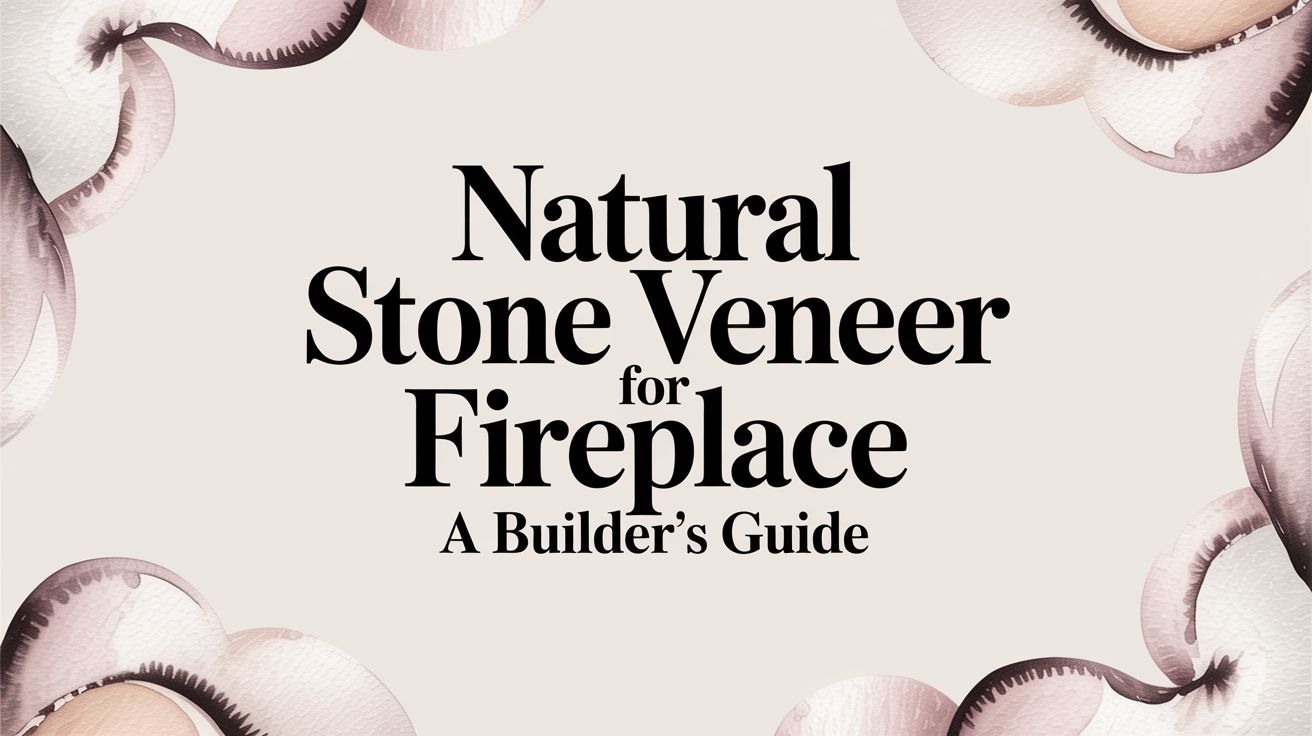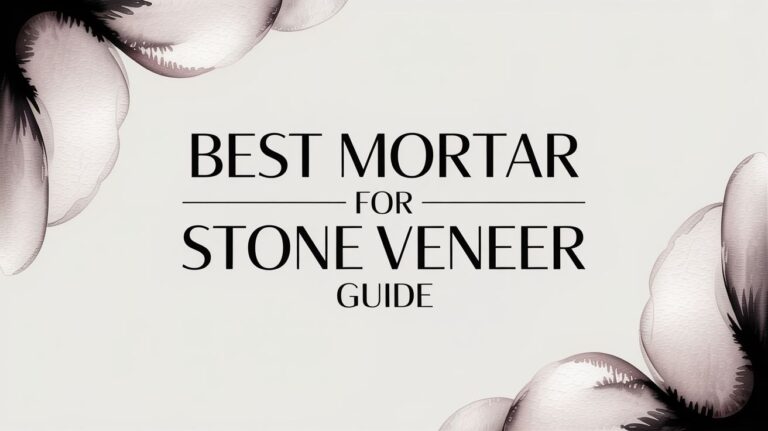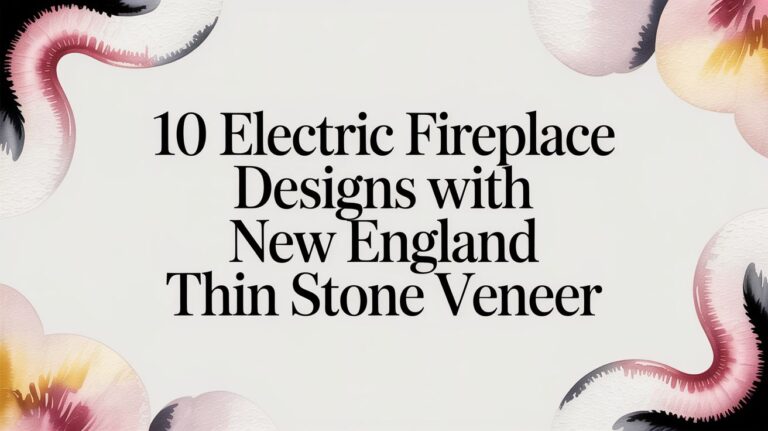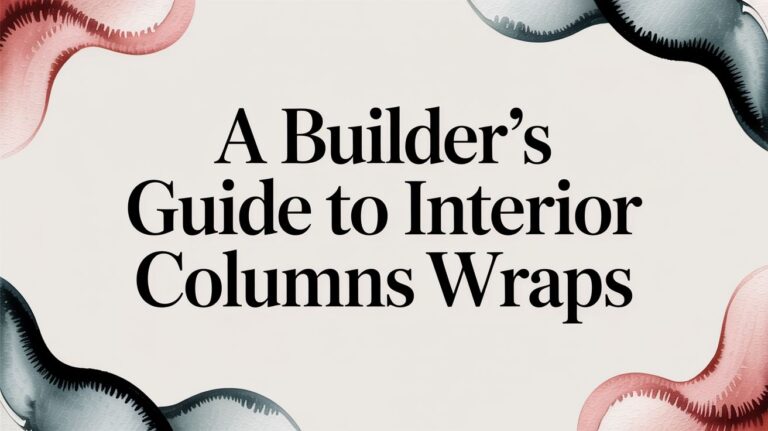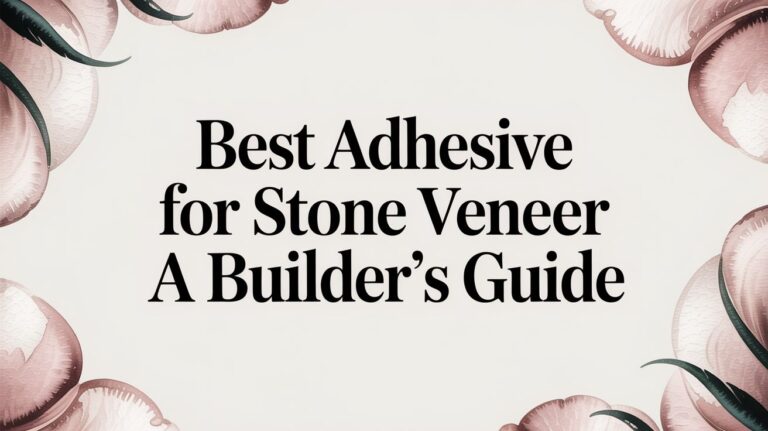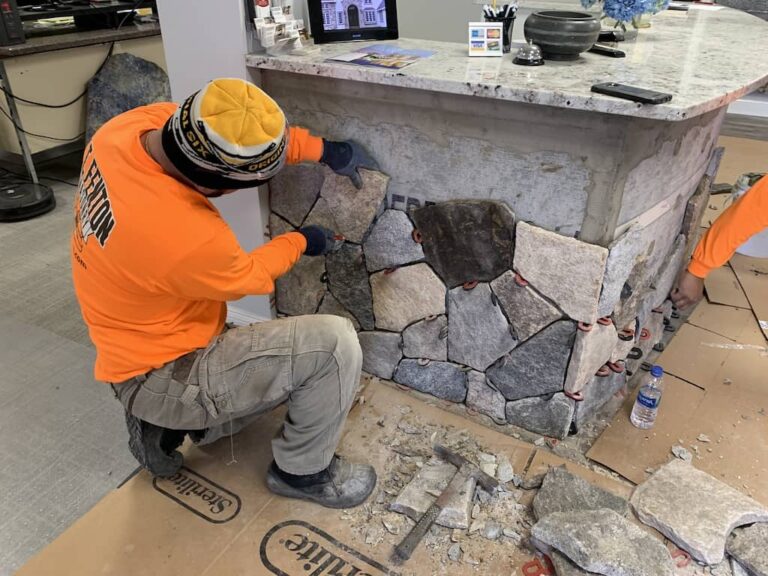Natural Stone Veneer for Fireplace: A Builder’s Guide
A fireplace becomes the visual and emotional center of a space, and using real New England thin stone veneer offers texture, authenticity, and manageable weight for both new builds and remodels. This is not a man-made, molded concrete product; it is 100% natural stone, quarried and crafted in the USA at our Littleton, Massachusetts facility. The manageable weight of thin veneer provides the look of a traditional, full-depth stone fireplace without requiring heavy structural support.
Explore the full range of Stoneyard’s authentic New England thin stone veneer.
Selecting Color and Shape for Your Fireplace
The two most critical decisions in designing a stone fireplace are selecting the color blend and the stone shape. Tone influences the mood—from the warmth of earth tones to the modern feel of cool grays—while the shape dictates the architectural style. The combination of these two elements defines the final look and feel of the project.
At Stoneyard, all our natural thin stone veneer is sourced from New England fields and quarries, ensuring every piece reflects the region’s authentic geology.
How Shape Defines Style
The cut of the stone sets the fireplace’s personality. Clean, linear patterns create a contemporary feel, while irregular, weathered shapes deliver a more rustic or traditional aesthetic. We fabricate five distinct shapes, each designed for a specific architectural outcome.
Ledgestone: Thin, linear strips of stone stacked in tight, horizontal rows. Ledgestone is ideal for clean, textured looks in contemporary homes and commercial spaces.
Ashlar: Similar to Ledgestone but with taller, more substantial pieces. Ashlar provides a larger-scale appearance suitable for grand fireplace walls.
Square & Rectangular: Classic, blocky cuts that create a formal, traditional pattern. This shape is a perfect fit for colonial-style homes and institutional buildings.
Mosaic: Irregular, angular stones fitted together to replicate a classic, hand-laid fieldstone wall. This shape is ideal for rustic great rooms and farmhouse chimneys.
Round: Naturally weathered, rounded stones similar to historic New England cobblestones. This shape is an excellent choice for lake homes, heritage projects, and foundations.
You can see how these shapes compare and transform a wall’s texture in our stone veneer shapes comparison guide.
How Color Influences Mood
While shape sets the style, color sets the mood. Warm, earthy tones make a room feel cozy, while cool grays and whites lend a more formal or modern edge. The colors in our New England collections are the stone’s natural mineral composition, not artificial pigments, which means they are guaranteed never to fade.
Unlike manufactured concrete products from brands like Eldorado Stone or Cultured Stone, the color in Stoneyard’s natural stone is integral to the material itself. It will not flake, peel, or fade from sun exposure or the heat of the fire.
Our five signature New England color blends include:
Boston Blend®: Our most versatile collection, a mix of gray, tan, and brown that works with nearly any architectural style.
Colonial Tan: A warm palette of gold, tan, and brown tones, perfect for traditional or coastal designs.
Greenwich Gray: A sophisticated collection of cool to warm grays, ideal for modern and commercial projects.
Newport Mist: Soft, light gray and white tones that create a bright, airy aesthetic for contemporary interiors.
Vineyard Granite: A rugged blend of gray and pink granite with natural mica flecks that add texture and character.
Combining shapes and colors achieves a specific design intent. A Colonial Tan Mosaic fireplace creates a warm, rustic centerpiece, while a Greenwich Gray Ledgestone fireplace delivers a sleek, textured feature wall for a modern living space.
Installation Considerations for Fireplaces
A professional installation is critical for a seamless, durable natural stone veneer fireplace. While thin veneer simplifies the process by eliminating the need for structural ledges, attention to detail is essential for a lasting result.
Substrate Preparation
The installation process begins with preparing the substrate to ensure a permanent bond.
Masonry Substrates: For existing brick or concrete block, the surface must be clean, unpainted, and structurally sound. A polymer-modified mortar scratch coat is applied directly to the masonry to create a mechanical bond.
Framed Walls: Wood or steel-framed walls require a multi-layer system: a weather-resistant barrier (WRB), metal lath, and a scratch coat. This builds a solid masonry base over the framing.
Corners & Edge Pieces
The key to achieving a full-depth stone appearance is using matching corner pieces. We craft L-shaped corners for every stone shape and color blend. Masons install these pieces first, alternating the long and short legs with each course to mimic traditional full-bed stonework. This technique creates the authentic look of a solid stone structure.
Heat Tolerance and Safety
Natural stone is non-combustible and handles heat exceptionally well. However, it is critical to follow the firebox manufacturer’s clearance specifications, which dictate the minimum safe distance between the firebox opening and any combustible materials like framing or a wooden mantel. Using a non-combustible substrate such as cement board around the firebox opening provides an extra layer of fire protection. Before starting, review local building codes and an ultimate building permit checklist to ensure compliance.
Interior vs. Exterior Applications
The installation process for an indoor fireplace and an outdoor chimney is nearly identical, with water management being the key difference for exterior work. All Stoneyard products are Harsh Climate Approved (HSA), with low water absorption and high density, making them immune to freeze-thaw cycles that can destroy manufactured concrete veneers from brands like Coronado Stone or Cultured Stone. For chimneys, proper flashing and a cap are critical for preventing water intrusion behind the stone.
For a detailed project overview, see our guide on how to add thin veneer to a fireplace.
Fireplace Design Application Ideas
A natural stone veneer fireplace is a powerful design element that can define a room’s character. The key is matching the right Stoneyard stone to the project’s vision to create an authentic, cohesive look.
Matching Stone to Architectural Style
Different architectural styles call for different textures and patterns. Stoneyard’s collections are crafted to meet these diverse needs.
Rustic Cabin or Farmhouse: The irregular, hand-laid look of Boston Blend® Mosaic is an excellent choice. Its warm earth tones enhance a cozy, traditional atmosphere.
Modern Loft or Commercial Space: For a clean, high-impact feature wall, Newport Mist Ledgestone delivers. Its soft gray and white tones and tight, linear lines add texture without overwhelming the space, making it ideal for dramatic floor-to-ceiling fireplace surrounds.
Traditional Home: The classic, orderly pattern of Square & Rectangular stone, particularly in a warm color like Colonial Tan, creates a timeless and stately fireplace that complements heritage details.
Advanced Design Concepts
An integrated design extends the stone beyond the firebox to create a more impactful statement.
Floor-to-Ceiling Walls: Running the veneer from the floor to the ceiling creates a sense of scale and permanence, anchoring the entire room.
Hearth and Mantel Details: A solid stone slab or carefully selected veneer pieces for the hearth creates a seamless transition. A mantel crafted from reclaimed wood or a simple stone beam complements the veneer’s texture.
Mixing Shapes or Blends: A skilled mason can blend different shapes or color collections for a custom look, such as using a rugged Mosaic pattern on the main body with a cleaner Ledgestone on the hearth for added visual interest.
For more design inspiration, explore general home design resources. The true value of real New England stone is its ability to bring authentic character to any project.
Maintenance, Durability, and Long-Term Value
Choosing real stone is an investment in permanence. Natural stone veneer offers multi-decade performance with minimal maintenance and no color fading, providing long-term value that manufactured substitutes cannot match.
Durability and Maintenance
All Stoneyard thin stone veneer is Harsh Climate Approved (HSA) and built to withstand New England’s punishing freeze-thaw cycles. This natural durability comes from the stone’s geological density and low water absorption rate. In contrast, cement-based products like Eldorado Stone or Cultured Stone are porous and can absorb water, leading to cracking and deterioration when frozen.
For indoor fireplaces, maintenance is simple: occasional dusting or cleaning with a pH-neutral stone cleaner is sufficient. Sealing is generally not required for the surround, though some choose to seal the hearth to make cleaning soot easier. Because the color is integral to the stone, it will never fade, peel, or flake.
Long-Term Value
While installation labor costs for real and manufactured stone can be similar, the long-term value proposition is not. A fireplace built with authentic stone is a permanent upgrade that adds significant resale value to a property. The authenticity, density, and permanence of real stone are clear advantages over manufactured alternatives. Market data shows that projects using real stone veneer can yield a high return on investment. You can review the ROI of stone veneer in this comprehensive analysis.
To see how an existing fireplace can be transformed, check out this stone veneer over brick fireplace project.
Explore the full Stoneyard Thin Stone Veneer Collection — real New England stone, made in the USA.
Order free samples at https://stoneyard.com/stone-samples/ or schedule a virtual showroom visit at https://stoneyard.com/request-a-quote/.
Why Real Stone Outperforms Manufactured Veneer
When choosing a fireplace material, the difference between real natural stone and manufactured concrete veneer is critical. While manufactured products attempt to replicate the look of stone, they cannot match its performance, durability, or authenticity.
Stoneyard’s thin stone veneer is 100% genuine stone, quarried or gathered from New England landscapes. Its color and texture are created by geology, not by surface-applied pigments. In contrast, brands like Eldorado Stone and Cultured Stone produce concrete veneers cast in molds. The color is a thin coating that can fade, peel, or flake over time, especially when exposed to heat and UV light, revealing the plain concrete base.
Real Natural Stone vs. Manufactured Concrete Veneer
|
Feature |
Stoneyard Natural Stone Veneer |
Manufactured Stone (Eldorado, Cultured Stone) |
|---|---|---|
|
Material Origin |
100% genuine stone, quarried or field-gathered from New England. |
Concrete mix poured into molds, with pigments added. |
|
Color Permanence |
Color is integral to the stone. It will not fade and develops a rich patina over time. |
Color is a surface application that can fade, peel, or chip, revealing the concrete base. |
|
Durability |
Harsh Climate Approved (HCA). Extremely low water absorption, resistant to freeze-thaw damage. |
Porous concrete can absorb water, leading to cracking and spalling in freezing temperatures. |
|
Authenticity |
Each piece is unique. No two stones are identical, providing true one-of-a-kind character. |
Repetitive patterns are common due to the use of molds. Can look artificial up close. |
|
Heat Resistance |
Naturally formed to withstand immense heat and pressure. Ideal for fireplace surrounds. |
Can be damaged by high heat. Pigments may discolor or break down near the firebox. |
|
Long-Term Value |
A permanent home upgrade that adds significant resale value. |
Lower perceived value. May require replacement due to fading or damage, reducing ROI. |
Choosing Stoneyard’s natural stone is an investment in authenticity and performance that concrete products cannot match, ensuring your fireplace remains a timeless centerpiece.
Burning Questions Answered
Here are answers to common questions about using natural stone veneer for a fireplace project.
Can Thin Stone Veneer Go Right Over My Old Brick Fireplace?
Yes, this is a common and effective application. Provided the existing brick is structurally sound, clean, and unpainted, it serves as an excellent substrate. A mason will apply a polymer-modified mortar scratch coat to the brick to create a strong mechanical bond for the new stone veneer, allowing you to achieve an authentic New England stone look without a full teardown. For a deeper dive, read our guide on choosing the perfect stone for your fireplace.
How Much Does This Stuff Actually Weigh?
Stoneyard’s real thin stone veneer is sawn to approximately one inch thick, keeping its weight under 15 pounds per square foot. Traditional full-bed stone can exceed 50 lbs/sq ft and requires a dedicated foundation. The lighter weight of thin veneer means it can be safely installed on standard interior walls without requiring additional structural support, making it ideal for remodels.
Does a Stone Fireplace Need Sealing or a Lot of Upkeep?
For an indoor fireplace, our natural stone veneer is exceptionally low-maintenance. Regular dusting or occasional cleaning with a pH-neutral stone cleaner is all that is required. Sealing the surround is typically unnecessary due to the stone’s natural density, though some homeowners choose to seal the hearth area to simplify cleanup of soot or spills.
The color in real stone is part of the stone itself. Unlike concrete-based products from brands like Eldorado Stone or Coronado Stone, our authentic stone will never fade, flake, or peel away—even with the constant heat from your fireplace.
What Makes New England Stone So Tough?
The durability of our stone is a result of its geology. Sourced from New England, this stone is naturally dense with a very low water absorption rate. This inherent property makes it highly resistant to the freeze-thaw cycles that can destroy porous materials like manufactured concrete. Because all our products are Harsh Climate Approved (HCA), they are guaranteed to withstand the elements for decades, maintaining their structural integrity and appearance on both indoor fireplaces and exposed outdoor chimneys.
